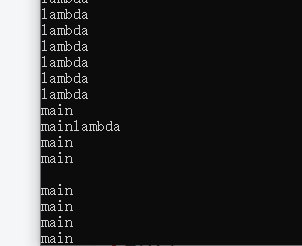1 添加头文件#include <thread>
2 使用全局函数作为线程函数
#include <iostream> #include <thread> #include <string> using namespace std; void ThreadFunc1() { std::cout << "ThreadFunc1" << std::endl; } void ThreadFunc2(int data) { std::cout << "ThreadFunc2"<<" "<<data << std::endl; } void ThreadFunc3(int data1,int data2,string str) { std::cout << "ThreadFunc3" << " "<< data1 << " "<< data2 << " "<< str << std::endl; } int main() { thread th1(ThreadFunc1); th1.join(); int data1 = 10; thread th2(ThreadFunc2,data1); th2.join(); int data2 = 100; string str = "StrTest"; thread th3(ThreadFunc3, data1,data2,str); th3.join(); return 0; }
3 使用类成员函数作为线程函数
#include <iostream> #include <thread> #include <string> using namespace std; class Foo { public: void ThreadFunc1() { std::cout << "ThreadFunc1" << std::endl; } void ThreadFunc2(int data1,int data2) { std::cout << "ThreadFunc2" << " " << data1 << " " << data2 << std::endl; } }; int main() { Foo foo; thread th1(&Foo::ThreadFunc1,foo); th1.join(); int data1 = 10,data2 = 100; thread th2(&Foo::ThreadFunc2, foo,data1,data2); th2.join(); return 0; }
4 使用lambda表达式作为线程函数
int main() { thread th([] {while (1) { std::cout << "lambda" << endl; } }); while (1) { std::cout << "main" << endl; } th.join(); return 0; }
结果如下:

5 leetcode练习
题目描述:
public class Foo { public void one() { print("one"); } public void two() { print("two"); } public void three() { print("three"); } } 三个不同的线程将会共用一个 Foo 实例。 线程 A 将会调用 one() 方法 线程 B 将会调用 two() 方法 线程 C 将会调用 three() 方法 请设计修改程序,以确保 two() 方法在 one() 方法之后被执行,three() 方法在 two() 方法之后被执行。
class Foo { public: Foo() { } void first(function<void()> printFirst) { // printFirst() outputs "first". Do not change or remove this line. std::lock_guard<std::mutex> lock(mx_); printFirst(); number_ = 1; } void second(function<void()> printSecond) { // printSecond() outputs "second". Do not change or remove this line. while (1) { if (number_ == 1) { std::lock_guard<std::mutex> lock(mx_); printSecond(); number_ = 2; break; } } } void third(function<void()> printThird) { // printThird() outputs "third". Do not change or remove this line. while (1) { if (number_ == 2) { std::lock_guard<std::mutex> lock(mx_); printThird(); number_ = 3; break; } } } std::mutex mx_; int number_ = 0; };
class Foo { public: Foo(){} void first(function<void()> printFirst) { // printFirst() outputs "first". Do not change or remove this line. mx_.lock(); printFirst(); number_ = 1; mx_.unlock(); } void second(function<void()> printSecond) { // printSecond() outputs "second". Do not change or remove this line. while (1) { if (number_ == 1) { mx_.lock(); printSecond(); number_ = 2; mx_.unlock(); break; } } } void third(function<void()> printThird) { // printThird() outputs "third". Do not change or remove this line. while (1) { if (number_ == 2) { mx_.lock(); printThird(); number_ = 3; mx_.unlock(); break; } } } std::mutex mx_; int number_ = 0; };
class Foo {//三个线程分别有各自的函数,可以不用加锁 public: Foo() {} void first(function<void()> printFirst) { // printFirst() outputs "first". Do not change or remove this line. printFirst(); number_ = 1; } void second(function<void()> printSecond) { // printSecond() outputs "second". Do not change or remove this line. while (1) { if (number_ == 1) { printSecond(); number_ = 2; break; } } } void third(function<void()> printThird) { // printThird() outputs "third". Do not change or remove this line. while (1) { if (number_ == 2) { printThird(); number_ = 3; break; } } } int number_ = 0; };